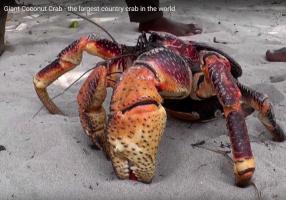 Coconut crabs are the stuff of nightmares. They live on remote coral atolls and are the largest land-living arthropod in the world. They can grow to over three feet long and weigh up to about 9 pounds. They can climb trees and use their immensely powerful claws to rip open coconuts. Recently scientists have discovered that they also hunt and eat sea birds.
Coconut crabs are the stuff of nightmares. They live on remote coral atolls and are the largest land-living arthropod in the world. They can grow to over three feet long and weigh up to about 9 pounds. They can climb trees and use their immensely powerful claws to rip open coconuts. Recently scientists have discovered that they also hunt and eat sea birds.
Mark E Laidre, a biologist at Dartmouth College, had heard stories of the crabs hunting sea birds and set out to investigate. He traveled to the Chagos Archipelago in the Indian Ocean. While crabs are generally known as scavengers, Laidre had never before encountered a crab which hunted which hunted its prey.
In a recent paper, he writes:
In Chagos, the first hint of predation on vertebrates by coconut crabs came when I inventoried a crab’s underground lair on 5 Feb 2016. Deep inside the crab’s burrow was the carcass of a nearly full-grown red-footed booby (Sula sula), one of the largest birds on Chagos (Carr 2011). Then on 2 Mar 2016, in the middle of the night, I observed a coconut crab attack and kill an adult red-footed booby. The booby had been sleeping on a low-lying branch, less than a meter up the tree. The crab slowly climbed up and grabbed the booby’s wing with its claw, breaking the bone and causing the booby to fall to the ground, where it was unable to fly. The crab then approached the bird, grabbing and breaking its other wing (Figure 1). The booby struggled and pecked at the crab, but the crab retained its grip with both claws, kicking at the bird with its ambulatory legs (https://youtu.be/XIRfCoauxbo). Five more coconut crabs came to the site within 20 minutes, likely cueing in on the blood with their neurologically acute olfactory sense (Stensmyr et al. 2005). The attacker responded by dragging the booby several meters away, and then released its grip. As the booby lay paralyzed, the crabs fought, eventually tearing the bird apart over several hours, carrying it away, and consuming it.
A video of the coconut crab attack:

Read about these crabs several years ago.
The children catch them by tricking them, when the come down the tree, they won’t let go until the feel the ground. The crabs can’t tell if its the ground or the bottom of a container and let go of the tree.
3-feet claw tip to claw tip!
10 Ginormous Facts
About Coconut Crabs
http://mentalfloss.com/article/82033/10-ginormous-facts-about-coconut-crabs